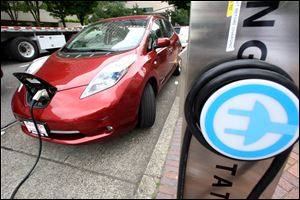
PUTTING A JOLT INTO ZERO EMISSIONS
8 states join forces to get more charging stations constructed
10/25/2013
A Nissan Leaf charges at an electric-vehicle charging station in Portland, Ore. The governors of eight states, including California and New York, pledged Thursday to get 3.3 million zero-emission vehicles on roadways by 2025 in an effort to curb greenhouse gas pollution.
SAN FRANCISCO — Eight states, including California and New York, pledged Thursday to work together to dramatically multiply the number of zero-emission cars on the nation’s roads by speeding the construction of charging stations and other infrastructure.
The goal is to put 3.3 million battery-powered cars, plug-in hybrids, and other clean-burning vehicles on the roads in those states by 2025. That’s more than 15 times as many zero-emission vehicles projected to be in use in the entire United States by 2015.
Auto dealers say networks of charging stations and other conveniences are crucial to winning over drivers who are accustomed to pulling up to the gas pump and fear getting stranded by a dead battery.
The other states in the pact are Massachusetts, Maryland, Oregon, Connecticut, Rhode Island, and Vermont. The eight states together represent about 23 percent of the U.S. auto market.
Auto makers lauded the agreement as important toward getting consumers interested in these technologies, which until now have been slow to catch on because of worries over electric car range.
“[3.3 million] is not an achievable goal given what we’re doing today from an infrastructure investment standpoint. It’s just not,” said Dan Gage, a spokesman for the Alliance of Automobile Manufacturers in Washington, which represents Toyota Motor Corp., General Motors Co., and 10 others.
“Up to this point there’s been a lack of consumer interest, and a lot of that has to do with investment in infrastructure,” he said.
Each state has already separately adopted rules to require a percentage of new vehicles sold to be zero emission by 2025. California’s mandate of 15.4 percent calls for a total of 1.5 million zero-emission vehicles to be on the state’s roads by that time.
While the agreement signed Thursday requires no specific financial commitment from each state, they have all vowed to work together to smooth building codes and other regulations in a way that will allow a quick rollout of new charging stations.
“The idea is to make it easier for customers to operate and use zero-emission vehicles; this in turn will help pave the way for success of the auto industry,” Mary Nichols, chairman of the California Air Resources Board, said.
Deb Markowitz, Vermont’s natural resources secretary, said her state has not put a cost on achieving the goals but believes in the end the state will partner with private companies to help them build charging stations and other needed infrastructure.
Getting 3.3 million of these vehicles will be a steep curve.
In California, plug-in-hybrids and electric vehicles currently make up less than 2 percent of the auto market.
There are now 16 zero-emission vehicles from eight manufacturers on the market: nine that run on batteries alone, two hydrogen fuel cell cars, and five plug-in hybrid models, which can run on battery alone or gasoline.
Officials say that every automaker will have a zero-emission model by 2015.
Car dealers, who are under pressure to help meet these 2025 goals, say getting fueling infrastructure such as charging stations in place quickly is the only way to get average consumers used to a new product that requires new driving habits.
“We think that is going to be necessary for some of the range anxiety and other acceptance barriers that need to be broken down,” said Brian Maas, president of the California New Car Dealers Association.